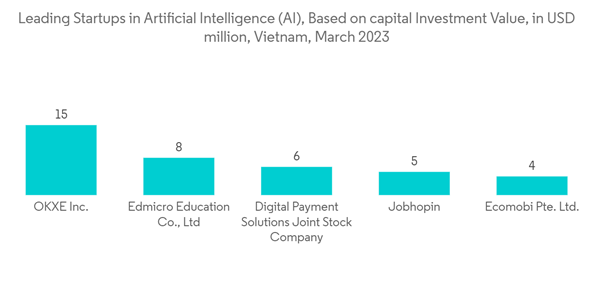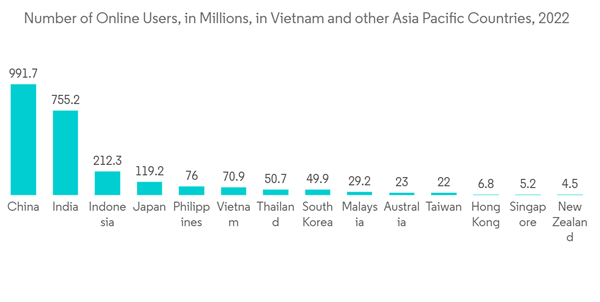The Vietnam ICT Market was valued at USD 8.30 billion the previous year and is expected to grow at a CAGR of 8.31%, reaching USD 13.32 billion by the next five years. The Vietnam ICT market is primarily driven by the increasing government initiatives to boost digital transformation in the public sector, growing adoption of advanced hardware and software solutions in end-user industries, and growth in new product launches by major market vendors operating in the country.
This product will be delivered within 2 business days.
Key Highlights
- Vietnam's information and communication technology (ICT) market has grown steadily over the past few years. The country is considered one of Southeast Asia's most advanced ICT markets, with a strong digital infrastructure and a tech-savvy population.
- The Vietnamese government has taken several initiatives to foster new developments. According to the Economy Southeast Asia Report, Vietnam's digital economy is anticipated to reach USD 50 billion by 2025, creating new growth opportunities for the ICT market.
- The government approved the National Digital Transformation Program through 2025, with a vision to 2030, which will further support the growth of the ICT market. World Bank data shows that Vietnam's digital economy grows 10 percent annually and could exceed USD 200 billion by 2045. Additionally, to cultivate the country into an innovation and AI hub in ASEAN and the world, the government issued a national strategy on research and development applications for AI until 2030. Such government investments will help start-up companies offer ICT solutions in the market.
- The inadequate ICT infrastructure in certain regions of Vietnam is a significant restraint in the Vietnam ICT market. While major cities have seen significant improvements, rural areas still face connectivity issues, including limited broadband coverage and unreliable network infrastructure. Additionally, the shortage of skilled professionals in the ICT industry is significantly challenging the growth of the ICT market in Vietnam. The rapid pace of technological advancements requires a well-trained workforce to develop, implement, and support ICT solutions. Vietnam faces a gap between the demand for skilled ICT talents and the availability of qualified individuals, which can challenge the growth and innovation potential of the market.
- The COVID-19 pandemic drove people to opt for the work-from-home mode and increased their time spent watching videos and playing games, leading to increased Internet penetration and a demand for data competition. To address this, Jones Lang LaSalle (JLL) has received numerous requests to rent land or lease buildings to construct and develop Tier-3 or Tier-4 data centers in Vietnam, creating new growth opportunities for the ICT market.
Vietnam ICT Market Trends
Increasing Investment on Key Technologies (Cloud Technology and Artificial Intelligence) is Expected to Drives the Market
- There has been an increasing demand for cloud computing technology in recent years because cloud solutions providers offer several benefits but also expose hosted data to severe risks such as privacy and identity theft. For instance, as part of national goals for digitalization, the Ministry of Information and Communications (MIC) aims to expand the market share covered by domestic CSPs (cloud service providers) to 70 percent by 2030.
- The government and large corporations have invested heavily in core technology areas, such as artificial intelligence (AI) and cloud computing. For instance, the Vietnam International Bank (VIB) signed a three-year strategic partnership with Microsoft Azure to deploy multi-cloud on the Microsoft Azure premise, which will further increase the growth of the cloud computing market.
- Additionally, growing investments in advanced technologies, coupled with growth in funding to innovative startups, further drive the development of the market. For instance, according to the OCED data, as of March 2023, OKXE Inc. was the leading Artificial Intelligence (AI) startup in Vietnam, with a capital investment value of USD 15 million, followed by Edmicro Education Co., Ltd. with a total capital investment value of USD 6 million.
- Increasing investment in infrastructural development projects would create new growth opportunities for the ICT market. Viettel Cloud, for example, has 13 data centers in Vietnam and plans to invest over USD 400 million to expand the scale to 17,000 racks by 2025. Following the roadmap, in 2030, the total investment would reach USD 1.6 billion, with 34,000 racks meeting international standards.
- According to a report published by Google, Vietnam has a thriving startup scene, with a rapidly growing number of innovative startups emerging in various sectors, such as e-commerce and fintech. Vietnam is predicted to achieve the highest growth of 31% in the digital economy in Southeast Asia between 2022 and 2025.
IT and Telecom Industry Vertical Segment is Expected to Hold Significant Market Share
- The IT and Telecom sector in the country has been thriving rapidly in the past few years. According to the 2023 GSMA Mobile Economy, The government of Vietnam is also aiming to upgrade mobile infrastructure and make 5G universal by 2030, offering new services and improved networks. The online population in the country is also increasing. According to PPRO, In 2022, the online population in Vietnam amounted to 70.9 million.
- Expanding network infrastructure, including fixed and wireless broadband, is a longer-term supporting trend for ITC market growth. For instance, in May 2022, Casa Systems signed a memorandum of understanding (MoU) with Vietnam Posts and Telecommunications Group (VNPT) to introduce next-generation 5G technologies, such as cloud-native 5G Core, RAN, and fixed wireless access (FWA) solutions in Vietnam.
- According to the MIC's Authority of Telecommunications, telecoms network infrastructure has been expanded to cover 100 percent of communal-level localities. The 2G, 3G, and 4G mobile networks have covered 99.8 percent of the population, while 5G has been piloted in 16 provinces and cities. Such initiatives from the government would create new growth opportunities for telecom service providers.
- Furthermore, the government has plans to expand its network coverage from 3G and 4G to 5G networks. For example, the Ministry of Information and Communications (MIC) has reported that it has finished installing 5G stations using open radio access network (ORAN) technology, with download and upload speeds of 900 Mbps and 60 Mbps, respectively.
Vietnam ICT Industry Overview
The Vietnamese ICT market is fragmented, with the presence of major players like Microsoft Corporation, Cisco Systems Inc., Viettel, Qualcomm Technologies, Inc., and Google LLC (alphabet Inc.). Players in the market are adopting strategies such as partnerships and acquisitions to enhance their product and service offerings and gain sustainable competitive advantage.- May 2023 - HGC Global Communications Limited (HGC), an ICT service provider and network operator, and Telehouse Vietnam, a premier ICT solutions provider, signed the Joint Marketing Agreement to provide EdgeX by HGC Global Communications Limited in the Vietnam market as part of the strategy to implement EdgeX by the company in Asia to support the emerging economies. By bringing the EdgeX infrastructure to Hanoi with Telehouse Vietnam, HGC expands its presence in Vietnam by extending its efficient services to the North.
- May 2022 - Viettel Group announced a partnership with Qualcomm Technologies Inc. to develop a next-generation 5G Radio Unit (RU) with massive MIMO capabilities and distributed units (DUs). The collaboration aims to introduce 5G network infrastructure and services in Vietnam and globally.
Additional Benefits:
- The market estimate (ME) sheet in Excel format
- 3 months of analyst support
This product will be delivered within 2 business days.
Table of Contents
1 INTRODUCTION
4 MARKET INSIGHTS
5 MARKET DYNAMICS
6 KEY TECHNOLOGY INVESTMENTS
7 MARKET SEGMENTATION
8 COMPETITIVE LANDSCAPE
Companies Mentioned (Partial List)
A selection of companies mentioned in this report includes, but is not limited to:
- Microsoft
- IBM
- Amazon
- Cisco Systems
- Qualcomm
- Alibaba
- Informatica
- Dell Technologies
- CA Technologies
- Check Point
Methodology

LOADING...










